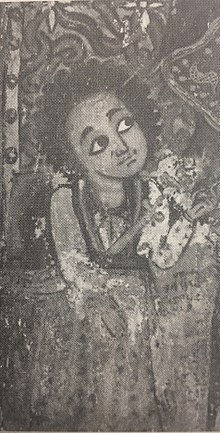Sabagadis Woldu
Sabagadis Woldu ሳባጋዲስ ዎልዱ | |
|---|---|
 A portrait of Sabagadis seeking the intercessions of St. Mary, on the wall iconography at the church of Gunda Gunde, Tigray. | |
| Governor of Tigray | |
| In office 1822–1831 | |
| Preceded by | Wolde Selassie |
| Succeeded by | Wube Haile Maryam |
| Shum of Agame | |
| In office 1810–1831 | |
| Preceded by | Woldu Kumanit |
| Succeeded by | Aregawi Sabagadis |
| Personal details | |
| Born | 1780 Agame, Tigray Province, Ethiopian Empire |
| Died | 1831 Debre Abbay, Ethiopian Empire |
| Parents |
|
Sabagadis Woldu (
Biography
Early life
Of
Rise to Power
After the death of Wolde Selassie, Sabagadis was one of the strongest chiefs seeking to succeed the Ras. He fought a series of devastating wars with regional contenders and finally acquired the Tigrayan overlordship in 1822. Sabagadis governed Tigray for a decade by appointed loyalist chiefs and members of his family.
Assuming the title of Dejazmatch, he followed the ambitions of his predecessors to remove Yejju Were Sheik dynasty(Were Sheik Wollo) political supremacy from Gondar. This was particularly the case after the death of Ras Gugsa Mersa in 1825. To this end, he requested British recognition as well as the supply of military trainers, experts in various fields, and more firearms to boost his army.[1]
Sabagadis also masterminded strong political and military alliances with some prominent regional chiefs in northern Ethiopia, especially Dejazmatch Wube Hailemariam of
Three of his letters have survived. One to the
Sabagadis maintained constant communication with the most important Christian lords in Ethiopia. Building upon his reputation, he formed a coalition with the lords of
Neither Sabagadis foreign contacts nor his military pact with Wube Hailemariam bore fruit. He was soon overtaken by a fresh outbreak of extensive fighting engulfing the whole of northern Ethiopia. Maruya won Wube to his side after initial military encounters led to the rampaging of his province of Semien.[1] In 1830, Sabagadis ravaged Semien, having defeated and even chased Wube out of his fortress called "Amba Tazzan" and "Amba Hay". Sabagadis then retired to Agame in Tigray after appointing Wube's rival and half-brother, Dejazmatch Merso Hailemariam, as his representative to Semien.[11]
Demise
However, this victory triggered Maruye, in collaboration with the fugitive Wube, to launch a vigorous campaign against Tigray. Three Tigrayan vassals of Sabagadis, including his own sons-in-law Dejazmatch Sahlu of Haramat, Dejazmatch Gebre Mikael of Dera, and Wedaj of Shire were also said to have defected. They conspired against Sabagadis with Wube and Maruye Gugsa.
Legacy
Sabagadis also established new churches such as Atsbi Selassie in
Nearly a year after his death, although he was a Tigrayan, people all over the Amhara provinces lamented the loss of Sabagadis:
Alas! Sabagadis, the friend of all,
Has fallen at Daga Shaha, by the hand of Aubeshat [i.e. Wube]! Alas! Sabagadis, the pillar of the poor, Has fallen at Daga Shaha, weltering in his blood! The people of this country, will they find it a good thing To eat ears of corn which have grown in the blood? Who will remember [St] Michael of November [to give alms]? Mariam, with five thousand Gallas, had killed him [him, i.e., who remembered to give alms]: For the half of a loaf, for a cup of wine,
The friend of the Christians has fallen at Daga Shaha.
— Quoted in Samuel Gobat, Journal of Three years' Residence in Abyssinia, 1851 (New York: Negro Universities Press, 1969), p. 401
Family
Sabagadis' sons were Wolde Mikael, Hagos, Kahsay, Sebhat and Shum Agame Aragawi.[16] The later was actively involved in power struggles in Agame. A number of other children are claimed for him: Kassa, Balgada-Ar'aya (who rebelled against Wube and his older brother Wolde Mikael in 1838, and was defeated by them), and several daughters including Dinqinash, who was married by her father to Ras Wube three years before the Battle of Debre Abbay.[17]
Notes
- ^ ISBN 978-3-447-06246-6.
- ^ Richard K.P. Pankhurst, History of Ethiopian Towns (Wiesbaden: Franz Steiner Verlag, 1982), vol. 1 p. 210.
- ^ Coulbeaux, Jean-Baptiste, Histoire Politique et Religieuse d’Abyssinie: Depuis les temps les plus reculés jusqu’à l’avènement de Ménélik II, 3 vols. (Paris, Geuthner, 1928), pp.381-382.
- ISBN 9783447047999.
- ^ a b c d Berhe, Tsegay (1996). A History of Agame, 1822-1914. Addis Ababa: Addis Ababa University. pp. 40, 47–50. 59, 67, 70.
- ^ a b c Gebre, Taddesse (1973). Power Struggle in Tigray during the Zämänä Mäsafent. Addis Ababa: Addis Ababa University. pp. 19, 26.
- ^ Pearce, Nathaniel (1831). The Life and Adventures of Nathaniel Pearce. London. pp. 67, 291.
- ^ Nuovi documenti, p. 376; Abba Tekla Haimanont: Abouna Yacob, Paris, 1914, p.91
- ^ All three are translated with facsimiles of the original text in Sven Rubenson (editor), Correspondence and Treaties (1800-1854) (Evanston: Northwestern University Press, 1987), pp. 24–9.
- ^ Paul B. Henze, Layers of Time: A History of Ethiopia (New York: Palgrave, 2000), p. 123.
- ^ Rüppell, Eduard (1840). Reise in Abyssinien. Frankfurt am Main. pp. 273, 400.
- ^ Gobat, Samuel (1834). Journal of a Three Years' Residence in Abyssinia. London. pp. 280.
- ^ Mordechai Abir, The Era of the Princes: the Challenge of Islam and the Re-unification of the Christian empire, 1769-1855 (London: Longmans, 1968), p. 35.
- ^ A. Devlin, Abyssinia and its Apostle, May Lady Herbert translator (London, 1867), p. 78
- ^ Nosnitsin, Denis (October 2006). "Historical Records from Ethiopia: a Trilingual Document from Atsbi Debre Gennet Selassie, Tigray". Proceedings of the Workshop "European Schools of Ethiopian Studies: Poland & Germany". 41: 17–47.
- ^ Genealogical information provided courtesy by the board of the "Association for the Preservation Of Ras Sebhat" Adigrat, Ethiopia.
- ^ Pankhurst, pp. 212f.
